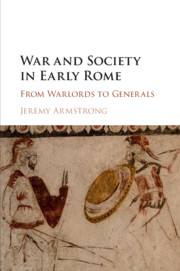Book contents
- War and Society in Early Rome
- War and Society in Early Rome
- Copyright page
- Dedication
- Contents
- Maps and figures
- Preface and acknowledgments
- Glossary
- Maps
- Introduction
- Chapter 1 The evidence
- Chapter 2 Rome in the sixth century
- Chapter 3 Rome’s regal army (c. 570–509)
- Chapter 4 Fighting for land (509–452)
- Chapter 5 The incorporation of the plebs (451–390)
- Chapter 6 The Gallic sack, the rebirth of Rome, and the incorporation of the Latins (390–338)
- Conclusions
- Bibliography
- Index
- References
Bibliography
Published online by Cambridge University Press: 05 April 2016
- War and Society in Early Rome
- War and Society in Early Rome
- Copyright page
- Dedication
- Contents
- Maps and figures
- Preface and acknowledgments
- Glossary
- Maps
- Introduction
- Chapter 1 The evidence
- Chapter 2 Rome in the sixth century
- Chapter 3 Rome’s regal army (c. 570–509)
- Chapter 4 Fighting for land (509–452)
- Chapter 5 The incorporation of the plebs (451–390)
- Chapter 6 The Gallic sack, the rebirth of Rome, and the incorporation of the Latins (390–338)
- Conclusions
- Bibliography
- Index
- References
- Type
- Chapter
- Information
- War and Society in Early RomeFrom Warlords to Generals, pp. 295 - 312Publisher: Cambridge University PressPrint publication year: 2016

